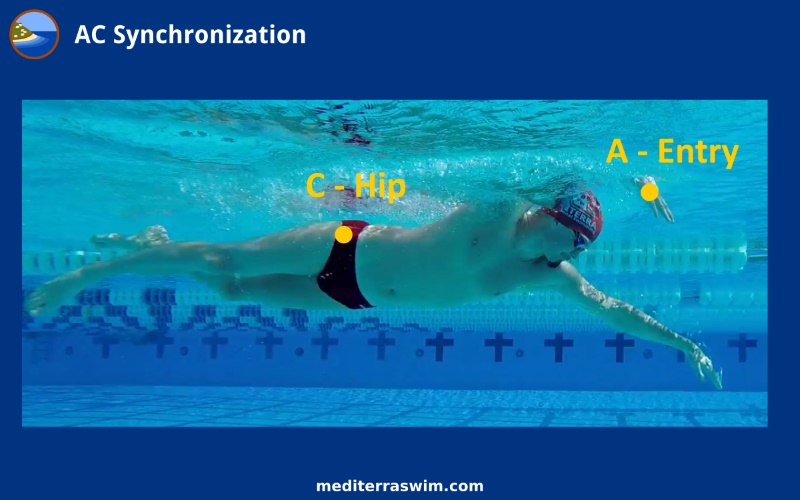
The Entry/Extension (A) and the Torso Rotation, represented by the Hip (C), is the easiest connection to study because on virtually every swimmer the rotation of the torso will wait until the recovery arm has come all the way forward and is ready to enter the water. That side of the body is held up in the air by the torso rotation until the entry arm is ready to slide down into the water. The drop of the shoulder allows the arm to drop into the water. Without even having to think about it, your Entry and Torso Rotation are likely, already approximately synchronized.
This is an automatic pattern that swimmer don’t often notice because it is already happening. But now you are going to pay attention to it because you can make that synchronization even better.
Instructions
At slow and moderate tempos you can allow gravity to initiate your torso rotation – the high side is being pushed downward, so when the arm swings into Entry position, you can just let gravity pull the arm and torso downward together. This is the most economical way to engage rotation power, obviously.
At tempos that are very fast for your conditioning, you may need to initiate the rotation of the torso with a push from your hip.
Rather than think of the whole torso together, it is easier to take just one point of the torso unit – the Hip – and have that point represent the entire unit. So, when you examine the connection between the Entry and the Torso, you can more specifically pay attention to the Hip on the same side as the Entry.
These two moving parts of the body should feel instantaneously connected in the same unified action, on this side of the body.
Practice CA where you emphasize using the Hip (C) to help push the Entry (A) into Extension to the target, as if connected with a mechanical rod.
Practice AC where you emphasize using the Extension (A) to pull the Hip (C) behind it, as if the wrist and the hip were connected by an elastic band.
Which one creates a more pleasing internal effect for you?
Which one produces a longer stroke (a lower stroke count) for you?

